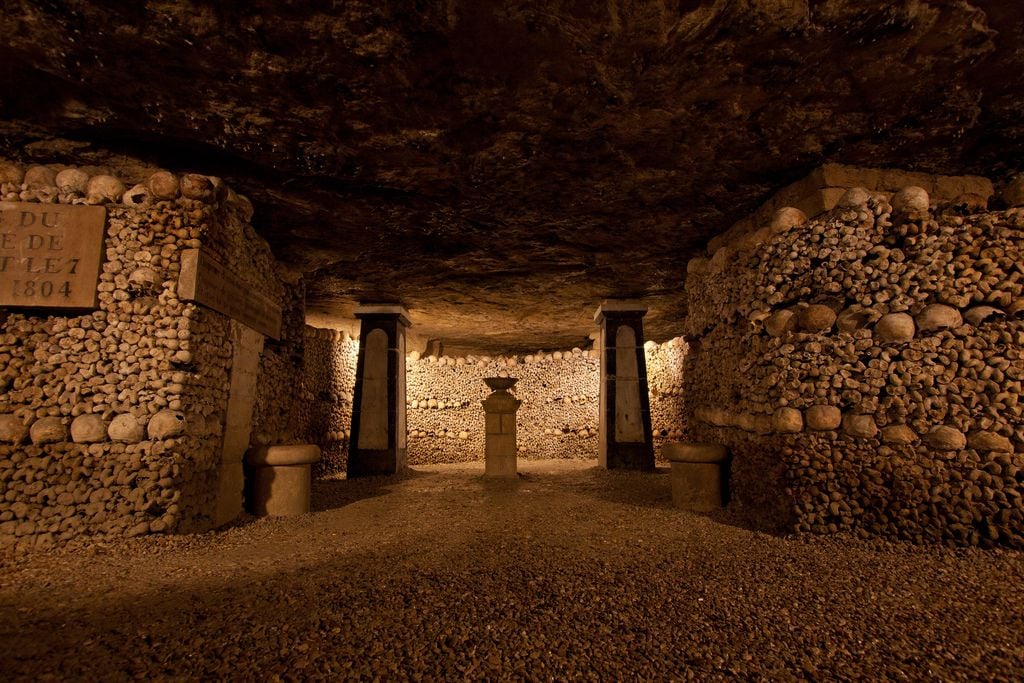Testament To Humanity : Ghoulish or Preservation of History?
"Twenty meters underground in a maze of galleries, visitors will discover an ossuary containing the remains of several million Parisians. This unique site recalls the history of these Parisians and invites visitors to take a timeless journey.""A veritable labyrinth in the heart of underground Paris, the Catacombs were installed in the tunnels of former quarries."Website, Catacombs of Paris"Happy is he who is forever faced with the hour of his death and prepares himself for the end every day."Subterranean Catacomb plaque
/https://tf-cmsv2-smithsonianmag-media.s3.amazonaws.com/filer/6a/45/6a45ef20-4391-4525-9093-76dc205f0ad7/plan_cata_paris_1857_jms.jpg)
People out for shuddering thrills must be the ones who respond to this invitation to visit the bowels of Paris for a view of what the future looks like. Death claims every living creature. We usually bypass any conceivable interest in what happens to our remains when we're no longer possessed of awareness; as our souls lift up and away from our bodies leaving them inert and all systems down. We have become an organic has-been. So how to explain the morbid fascination in viewing millions of skulls and bones in a vast underground mausoleum of endless corridors?
People do arrive in droves to personally witness the end of life's leftovers. A myriad, uncountable number of skulls and bones, all that is left when life departs and death descends. The anonymous bones of six million former residents of Paris are on display in the Paris Catacombs, placed there in 1786 when the government of the time thought it best to reduce the congestion created in city cemeteries, traditionally placed in the vicinity of parish churches. They chose an abandoned limestone quarry for the official new Paris ossuary.

What resulted was miles of tunnels, leading the priests of Catholic Paris to usher ceremonial processions of bone-laden carts into the quarries. There the bones were piled five feet in height, to a depth of 80 feet. Neat walls of skulls completed the process. With the emptying of each church cemetery a plaque was placed identifying the church and district the bones emanated from, along with their date of arrival. Descending a long spiral staircase one arrives in this underworld -- "Halt, this is the empire of the dead" -- to a one-mile subterranean public walkway.
Some fascinated visitors found it irresistible to attempt to come away with a souvenir. Their very own skull to bring home and contemplate from time to time, imagining the brain that once inhabited it, the consciousness and beliefs of the mind that expressed the experience of its wearer. Leading the Catacomb authority to wire the skulls together and post signs warning that all bags were to be checked at the exit. It cannot be known how many enterprising skull-thieves were staggered by opportunities lost thereby.
Elsewhere, throughout Europe, the Capuchin Order saw their monks adopt a strategy of hanging their dead brothers-in-Christ to dry following death, to occupy crypts filled with skeletons, opened to the public. Theirs was a mission to have people confront what will be. To come to grips with the reality of their future when their lives expired. To understand that in life they have but one opportunity to live well, following the edicts of the Church. Which would in time determine where they would appear, after death; heaven or hell.
 |
| Two severed, mummified arms cross one another to make the form of the Capuchin’s coat of arms. Photograph Dnalor 01 |
In Rome, the Capuchin Crypt holds bones of 4,000 monks who left life between the years 1528 and 1870, lined up in orderly rows for the gratification of visitors honoured to be invited to stand and gaze upon the past. "We were what you are ... you will become what we are now", reads a plaque instructively. A succinct, spine-chilling reminder of the mortality of all that lives. In Palermo, Sicily the Capuchins' crypt is a subterranean gallery with 8,000 "bodies without souls".
In the Czech Republic, monks in Kutna Hora decorate their ossuary with the bones of 40,000 people, many among them victims of the plague. There the monks 400 years ago indulged in artistic displays of bones, imaginatively designing and putting together a lavish chandelier constructed of every representative bone in the human body.
One needn't look to the far distant past to find skulls and bones memorialized as the link between the living and the dead. In our current century Cambodia under the malign dictator Pol Pot became, like China during the Cultural Revolution, a 'killing field'. And like the Russian Revolution that targeted land owners, intellectuals and opposition to the Communist takeover of yet another ancient country transforming itself for the modern era, Cambodia saw two million people slaughtered.
In the West, dead bodies, skulls and bones remain interred or are increasingly, cremated. To place skulls and bones on public display is no mere matter of social mores being transgressed in 'grotesque poor taste' but unlawful, falling under the prohibition of 'perpetrating an indignity' to a dead body. Where it is preferable to allow the dead to lie in undisturbed peace. In Cambodia the display of tens of thousands of skulls has another purpose, to mourn the inhumanity of man to man.
Labels: Cambodia, Crypts, Europe, Osuaries, Paris, Subterranean Bone Interments
0 Comments:
Post a Comment
<< Home